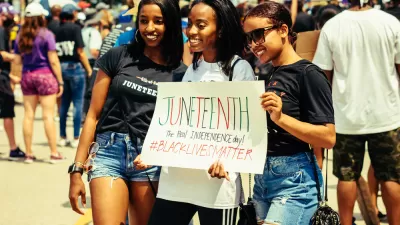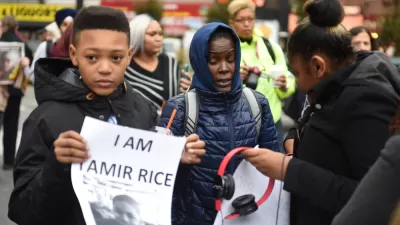The rise of white nationalist politics has many implications for the ideas of a just city.

The 2016 election has raised many intriguing questions for the planning profession. A month prior to the election, I wrote a Planetizen editorial discussing the fair housing implications of a potential Trump presidency. My earlier article discussed the potential role of the "Alt Right"—a fringe, White nationalist movement that has been energized by the Trump campaign—in a newly organized movement opposing fair housing. This follow up editorial takes a deeper look at this movement and its potential impact on fair housing and planning during the Trump presidency. More specifically, what does the white nationalism of the Alt Right movement mean for the planning profession, and how should planners respond? What can we learn from other oppositional movements to inform the work of planners in this new political environment?
Organized Fringe Movements and Planning: The Risks of Ignoring the Problem
It is not uncommon for planners to face forms of organized community resistance. Organized resistance to planning and development efforts have included a variety of issues, ranging from property rights, environmental protection, historic preservation, civil rights, and NIMBYism. These divergent interests are an important element of the balancing act of crafting and implementing development policy. As Planetizen has discussed in great detail, these disruptions can be powerful learning experiences.
But there is a natural tendency to disregard fringe protest movements that may seem irrational. For four years, I assisted grantees from the U.S. Department of Housing Urban Development's (HUD) Sustainable Communities Initiative (SCI) to build capacity while they developed regional sustainability plans. Planners developing SCI plans were surprised when they began to experience push back or concern from Tea Party stakeholders in their regions. Tea Party stakeholders voiced concerns that the SCI program was an attempt to force the implementation of the United Nation's sustainability framework, Agenda 21.
Clearly, SCI had no relationship to Agenda 21, nor was it part of an Obama Administration conspiracy to hand over control of U.S. land use policy to the United Nations. So many planners, noticing the Agenda 21 opposition's orientation toward conspiracy theory, chose to ignore or disregard these concerns. Disregarding Tea Party protests proved problematic, however, in regions where the Tea Party had political influence. The Tea Party's disruptions of SCI meetings became effective. Tea Party activism helped defund future Sustainable Communities Initiative projects in Congress and had a powerful impact on grantees in throughout the nation, particularly in Virginia and the Carolinas.
The Alt Right and Planning for a Just City
Similar to the Tea Party during the Obama Administration, the Alt Right is a growing movement, seeking to grow even more in influence under the Trump Administration. After President-elect Trump's surprising November victory, the Alt Right has gained exposure, celebrated Trump's victory and expanded its influence. The movement has reason to celebrate. Steve Bannon, former executive chair of Breitbart News Network, LLC (the parent company of Breitbart, a conservative blog which has long supported the Alt Right) has been appointed chief strategist for the Trump Administration. The movement has also celebrated the administration’s choice of Alabama Senator Jeff Sessions as attorney general. Senator Sessions has a long history of opposing fair housing and other civil rights legislation. More recently, leaders in the movement have threatened a backlash if the President-elect does not live up to his anti-immigrant and anti-integration campaign promises.
While the exact role and influence of the Alt Right in the Trump Administration is unclear, we can clearly understand the movement's views in relation to racial diversity and social justice. As described by the Southern Poverty Law Center, the Alt Right believes white Americans and "White America" are under threat from our nation's growing diversity, multiculturalism, and efforts to support social justice. The Alt Right opposes immigration and supports massive deportation. Sadly, we also can clearly see the extent of growing xenophobia and racism in the aftermath of the election. As documented by the Southern Poverty Law Center, there have been nearly 1,100 documented bias or hate-crime related incidents in the first month following the election.
With regard to the practice of planning, the Alt Right is most engaged and vehemently opposed to fair housing efforts and "local control" as a mechanism of racial segregation. Breitbart ran numerous articles in opposition to President Obama’s policies at HUD, calling them a "war on the suburbs." More radical (but highly visited) Alt Right blogs like Daily Stormer have called President Obama’s HUD policies an agenda of "Detroitification"—designed to kill American society. Another article on the same site warns fair housing will bring "crime and chaos that comes right out of these ghettos…to a town near you." The Alt Right movement has heralded future Attorney General Sessions for "not prosecuting federal diversity and fair housing" and has anticipated that future HUD Secretary Ben Carson will work to "resegregate housing as Head of HUD."
The Alt Right is not an organized movement in the traditional sense. It's primary battleground is online, not marching in the streets or even protesting at public meetings. Yet, efforts to spread disinformation and fake news while disrupting digital forums can be powerfully effective. As planners work to support a just city, to engage issues of fair and affordable housing, and to engage our nation's flourishing diversity, we can anticipate an empowered Alt Right to be a force of opposition.
Learning to Speak Differently: Making Policy Meaningful to People
If we are to engage fringe efforts such as the Alt Right, we can learn from the Agenda 21 and SCI experience. Grantees who successfully engaged with Tea Party resistance did so by listening to Tea Party stakeholder concerns and changing their approach to communication. As policymakers, we often get caught up in technical jargon and cling to an esoteric (and inaccessible) dialect. Terms such as Affirmatively Furthering Fair Housing or Sustainable Communities Initiative Regional Planning Program are inaccessible to many stakeholders. Those working to undermine such efforts can easily misappropriate jargon terms while spreading misinformation. SCI grantees learned to reframe and communicate the goals of sustainability planning efforts by avoiding technical terms, describing the values inherent in the regional planning effort, and working to incorporate the values of project opponents. We should think about similar strategies to better communicate policies moving forward, particularly policies that further the goal of sustainable, just cities.
Returning to Our Progressive Roots: Not Being Afraid to Claim the Moral High Ground
The challenge posed by the Alt Right is that common values might not be possible, particularly given the unique role of planners as advocates for communities that are marginalized or facing discrimination. Clearly, the racist and xenophobic values that are the bedrock of the Alt Right are not consistent with the goals of a just city or related policy issues such as fair housing. More concerning is that amplified expression of racist and xenophobic values, while publicly opposed by most people, can be very influential in fueling implicit racial biases and creating a toxic atmosphere where racism and xenophobia become normal. The only response to discrimination is to vigorously counter the idea in public dialogue and action, illuminating the impacts of policies and practices that are unjust and discriminatory.
Similar to other time periods in the country's history, the United States is going through a demographic transition, creating racial anxiety and breeding discrimination. We saw similar effects in the infancy of the planning profession in the late 19th and early 20th centuries, when immigrants flooded American cities and when African Americans moved en masse to northern cities in the "Great Migration." The growth of suburbia in the 20th century was a byproduct of racial anxiety, as “White Flight” emerged partially in response to changing demographics and efforts to desegregate schools. In the present period of social and demographic change, planners have an opportunity to support just cities and communities. We should not be afraid to claim the moral high ground, and we should not tip toe around discriminatory values that clearly conflict with our profession's obligation to support a just city.
Any change in a presidential administration brings challenges, opportunities, and anxiety. The contentious 2016 election has amplified this anxiety and led to unfortunate byproducts, such as the continued rise of the Alt Right. As professionals in this environment, we must stay engaged, adapt as necessary to be effective, but not retrench from our values. In a diversifying nation, filled with diverse cities, planners play a critical role in supporting an integrated society in which all members have access to opportunity and the chance to thrive.
Jason Reece, Ph.D., is an assistant professor of City & Regional Planning at the Knowlton School of Architecture, The Ohio State University.

Montreal Mall to Become 6,000 Housing Units
Place Versailles will be transformed into a mixed-use complex over the next 25 years.

Planetizen Federal Action Tracker
A weekly monitor of how Trump’s orders and actions are impacting planners and planning in America.

California High-Speed Rail's Plan to Right Itself
The railroad's new CEO thinks he can get the project back on track. The stars will need to align this summer.

Tenant Advocates: Rent Gouging Rampant After LA Wildfires
The Rent Brigade says it's found evidence of thousands of likely instances of rent gouging. In some cases, the landlords accused of exploiting the fires had made campaign donations to those responsible for enforcement.

Seattle’s Upzoning Plan is Ambitious, Light on Details
The city passed a ‘bare-bones’ framework to comply with state housing laws that paves the way for more middle housing, but the debate over how and where to build is just getting started.

DOJ Seeks to End USDOT Affirmative Action Program
The Disadvantaged Business Enterprise Program encouraged contracting with minority- and women-owned businesses in the transportation sector, where these groups are vastly underrepresented.
Urban Design for Planners 1: Software Tools
This six-course series explores essential urban design concepts using open source software and equips planners with the tools they need to participate fully in the urban design process.
Planning for Universal Design
Learn the tools for implementing Universal Design in planning regulations.
City of Camden Redevelopment Agency
City of Astoria
Transportation Research & Education Center (TREC) at Portland State University
City of Camden Redevelopment Agency
Municipality of Princeton (NJ)
Regional Transportation Commission of Southern Nevada





























